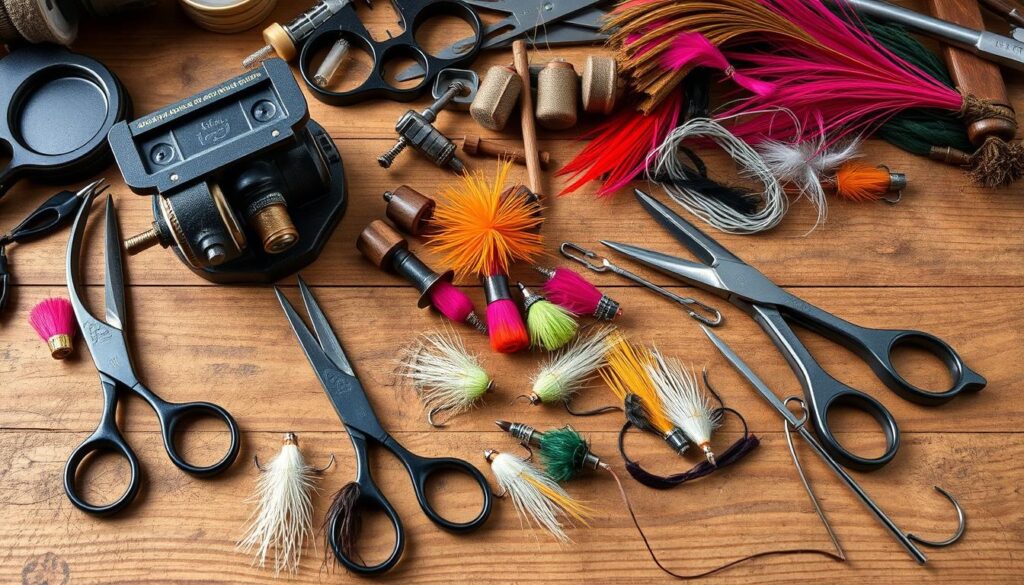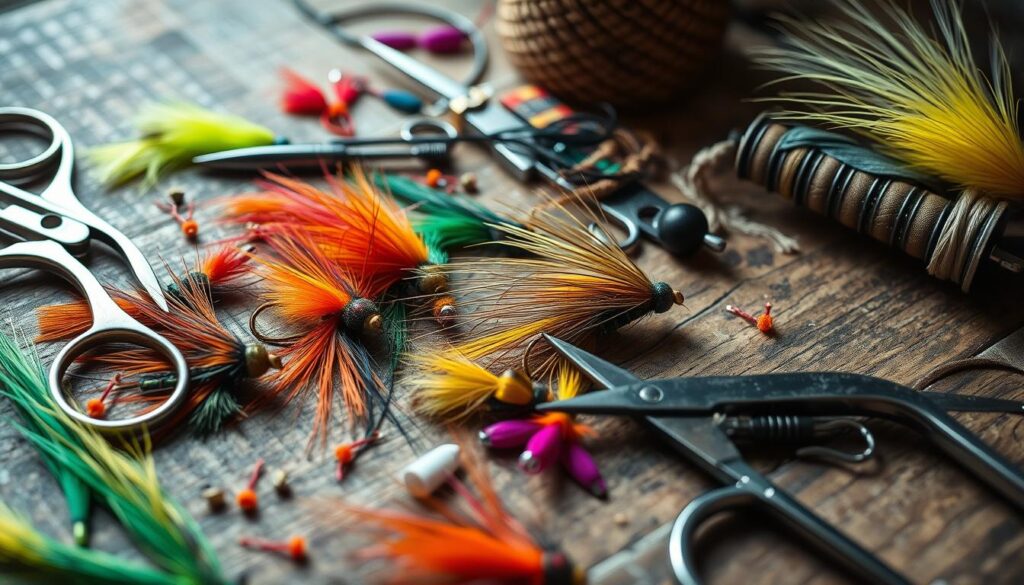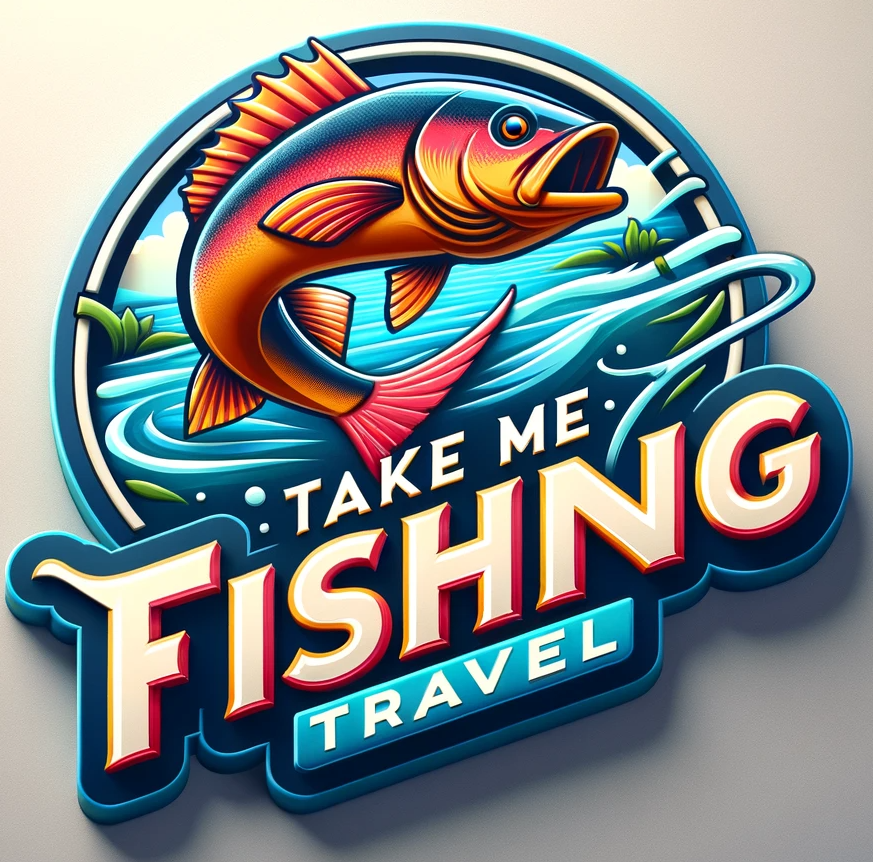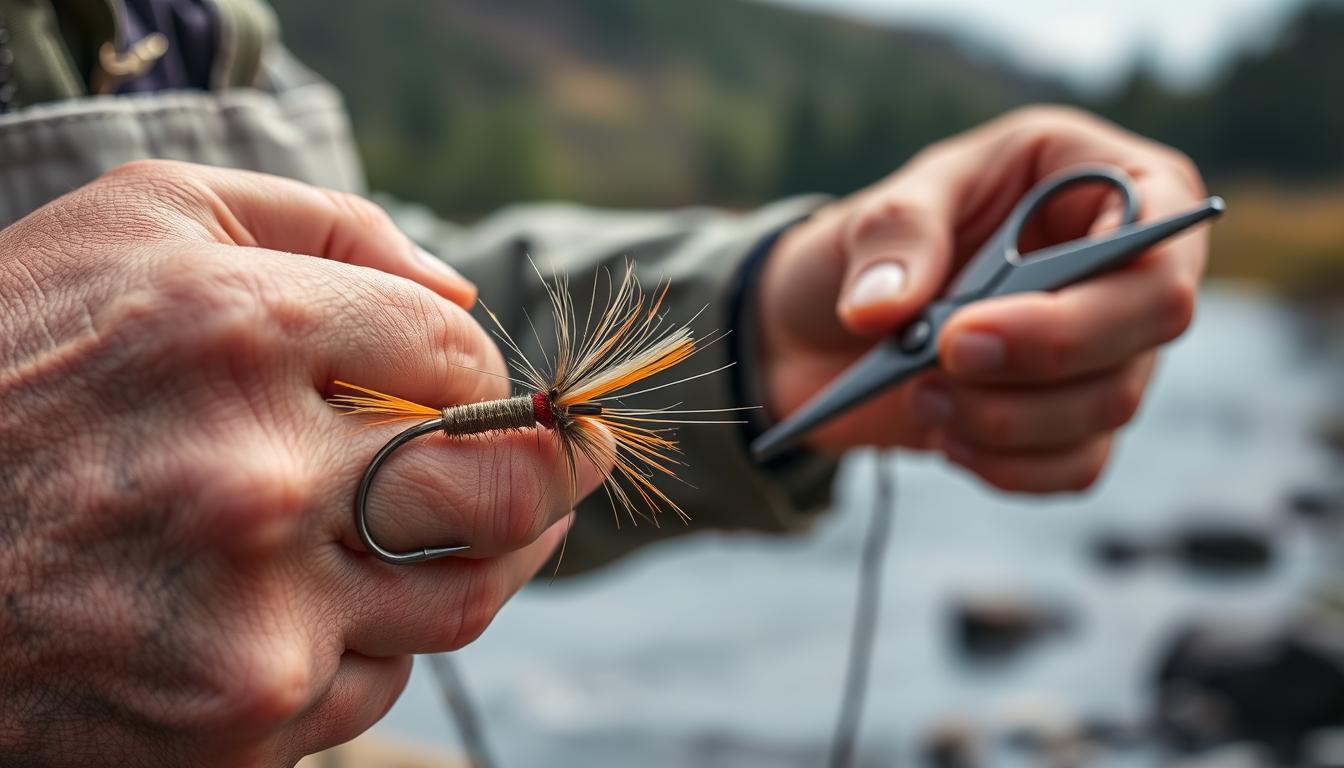This post contains affiliate links.
For every passionate angler, a time comes when simple flies aren’t enough. You crave more—more complexity, and more skill. This isn’t just about catching fish. It’s about the art of tying flies, the details that make them look real. It’s a labor of love, perfecting your craft, and always aiming higher.
Imagine a cool morning by the river, your hands busy with colorful materials, threads, and hooks. You’re not just making a fly; you’re creating a masterpiece that’ll trick the smartest fish. The joy of seeing your fly on the water, attracting fish, is unmatched.
Let’s start a journey together, learning advanced techniques to turn you into a fly tying expert. We’re mixing old skills with new ideas to make artificial flies come alive. This guide is for anyone wanting to improve, from experts to beginners eager for a challenge.
Key Takeaways
- Learn dubbing techniques essential for nymphs, wet, and dry fly patterns.
- Master the intricacies of different fly tying materials for creating realistic abdomens.
- Understand how to perfectly mimic the anatomy of aquatic life.
- Discover advanced techniques with detailed steps for constructing nymph abdomens using a dubbing loop.
- Explore the unique and award-winning fly tying methods by Barry Ord Clarke.
Are you ready to take your fly tying craftsmanship to the next level? Let’s dive in and reach new heights together!
Understanding the Art and Science of Fly Tying
Fly tying is part art, part science. At the 3rd Annual Fly Tying event, 25 participants, both newbies and experts, delved into this craft. They saw the skill involved and learned that fly tying mixes precision with creativity.
The Craftsmanship of Fly Tying
Fly tying is more than copying patterns. Dave Whitlock, a respected fly tier, showcased simple but effective flies. Beginners started with easy patterns like Cork Poppers and Streamers to gain skills.
Using different materials like hooks, threads, and feathers is key. They learned how texture and color impact a fly’s success. Practice and dedication are crucial for mastering fly tying.
The Importance of Aquatic Life Knowledge
Understanding water life is vital for fly tying. Hugh McDowell noted that personal style matters in fly creation. Knowing what fish eat and their behaviors is part of the science.
This event stressed the value of unique flies over store-bought ones. Making flies that closely mimic natural prey improves fishing success. It blends special knowledge into the design, making flies more appealing to fish.
Essential Fly Tying Materials and Tools
Crafting intricate fly fishing patterns starts with the right fly tying tools and tying materials. This journey combines craftsmanship and science. It invites you to explore both deeply.
Beginners can start with $50 to $75 for essential equipment. Every tool should serve a key purpose. Get a sturdy vise like the Colorado Anglers Super AA Vise 103 for $16.26. Add precision scissors like the Loon Outdoors Ergo Arrow Point Scissors at $14.98.

You’ll need special items like the ECO Flared Fly Tying Bobbin by Dr Slick for $5.29. Bobbins help smoothly apply thread to hooks. For example, use 70 denier thread for dry flies and 6/0 thread for nymphs and wet flies.
Your fly patterns depend on the materials you choose. Consider gold wire, chenille, pheasant skin, and cow elk hair. Each adds unique texture or lifts to your flies. Eyes and bead heads are also key for balance and weight in your patterns.
A variety of strong threads is crucial for efficient tying. Opt for Gel spun polyethylene (GSP) threads for their strength. Use 3/0 thread for bigger flies like streamers. Remember to use barbless hooks as required for trout fishing.
A bright workspace makes tying flies more fun. An optional Fly Tying LED Lite for $18.00 lights up your area. This reduces eye strain and improves your work. Add a basic fly tying kit for about $30 to get started on mastering this art.
To learn more, consider getting “Benchside Introduction To Fly Tying” by Leeson and Schollmeyer for $45. Or, the “Fly Tier’s Benchside Reference to Techniques and Dressing Styles” for $100. These books offer great insights.
A well-equipped fly tier’s bench has materials for different fly patterns. Use versatile items like cow elk hair and hackle feathers. Choose saddle or cape feathers based on the fly patterns. Your choice in hackle affects how the fly performs.
For more tips on picking the right materials, check out [this insightful guide]. It helps whether you’re after tuna or trout. The key is choosing the right materials and tools.
Advanced Fly Tying Techniques for Experienced Anglers
For seasoned anglers, mastering advanced fly tying techniques is a thrilling challenge. A.K. Best’s book, spanning 21 chapters, offers a deep dive into the craft. It teaches how layering and blending can imitate the natural look of aquatic prey.
Layering and Blending Techniques
Layering and blending help create realistic fly patterns. Using different fibers, tyers can mimic the look of insects. A.K. Best shows how to perfect these techniques with proper hand positions and hackling.
Complex Body Construction
Crafting complex fly bodies requires knowing how insects look and move. Best’s book shares tips on making accurate, moveable flies. He discusses techniques for detailed patterns, like quill-bodied sulphurs and lime trudes.
Articulated Fly Techniques
Articulated flies move like real insects in the water. Making them demands careful planning. A.K. Best offers advice on materials and tools, like the Renzetti tool caddy, to bring flies to life.
Achieving the Perfect Dry Fly Hackle
The right dry fly hackle is crucial for the fly’s buoyancy and look. A.K. Best explains how to avoid common problems, like cone-shaped hackles. This improves the fly’s floatation and appeal.
For more tips, check A.K. Best’s book. It includes solutions for issues like broken threads and uneven bodies. Each chapter is a step closer to mastering advanced fly tying.
| Feature | Description |
|---|---|
| Chapters | 21 |
| Author Experience | 35+ years, Professional Fly Tyers |
| Publication | October 2006 by THE LYONS PRESS |
| ISBN | 1-59228-956-8 |
| Pages | 224, Full-color Photographs |
Streamers and Nymphs for Advanced Fly Tying
Streamer fly tying and advanced nymphing need skilled hands. They also require deep knowledge of water ecosystems. Streamers and nymphs are made to look like larger water prey. They move like real organisms in water. In places like Thailand’s Andaman Sea and Gulf of Thailand, these skills are very useful. Knowing how to use patterns like the Woolly Bugger and Zebra Midge can make you much better at fly fishing.
The Versatility of the Woolly Bugger
The Woolly Bugger is great for many fishing situations. It works well for catching trout in rivers or big fish in the sea. It can look like many different small creatures, such as leeches or baitfish. This makes it important for both nymphing and using streamers. For the best results, use a 9-foot rod that’s 6 to 8 weight, with a leader that’s 4 to 6 feet and a tippet that’s 0X to 3X. Using double hauling to cast farther and different ways to move it, like strip retrieval or jigging, can make it work even better.

In places from Ken Lockwood Gorge to the Andaman Sea, the Woolly Bugger shows its value. It’s liked for how it can be changed to suit different situations. Other streamer patterns like the Sculpin and Zonker are also good. The way the Woolly Bugger is made, like using red UTC 140 Denier for its body and black bucktail for wings, makes it very effective.
Mastering the Zebra Midge
The Zebra Midge is a key pattern for nymphing, although it looks simple. Getting the size and color right is crucial for it to work. It’s a top choice among expert fly patterns because it looks so real. This makes it effective in many water types.
The Zebra Midge requires careful attention to detail. This includes using the right hook size, usually 18-22, and the right materials, like silver mylar tinsel for ribbing and thin black thread for the body. Knowing how to nymph, such as understanding where fish are in the water, is important. The Zebra Midge is a great choice, whether you’re fishing in cool places like Ken Lockwood Gorge or tropical waters in Thailand.
Adding advanced fly patterns like these to your skills will improve your fishing a lot. Trying them in places mentioned in this guide to offshore fishing in Thailand could be very rewarding. The Woolly Bugger and Zebra Midge show the creativity and precision needed to excel in fly tying.
Dry Fly Tying Techniques for Expert Tyers
Dry fly tying is an art that requires mastery. Expert tiers need to know many detailed techniques and materials. Patterns like the Parachute Adams and the Klinkhamer Special are famous. They offer unique challenges that test an expert’s skills.
The Parachute Adams
The Parachute Adams is key in dry fly patterns. It shows off effective design and tricks fish well in water. Expert fly tiers love it for its ability to look like many mayflies.
Perfecting the Parachute Adams involves:
- Finding the best hackle for top floatation.
- Wrapping the hackle evenly to make the fly float right.
- Making sure the tail and body look real and balanced.
The Klinkhamer Special
The Klinkhamer Special shines when imitating emergers. It’s great in dry fly tying because it looks like bugs emerging in water.
Key points in tying the Klinkhamer Special:
- Pick a curved hook to match the emerger’s shape well.
- Build the thorax and abdomen with the right look and materials.
- Get the parachute hackle just right for perfect water floatation.
The Parachute Adams and the Klinkhamer Special show the mix of art and science in fly tying. To get better at this, mastering these patterns is key. There are over 493 YouTube videos on tying, from Stonefly to Sea Trout flies. These resources can help you grow into an expert tier.
Barry Ord Clarke makes complex tying look simple. His book has 250 pages and QR codes for video lessons on different patterns. It’s a great tool for tying fans around the world.
Creating Realistic Terrestrial Patterns
When it comes to fly tying, terrestrial fly patterns are a big challenge. These realistic fly designs mimic land-based insects, helping anglers during late-summer fishing. Fly tyers put a lot of effort into the details, making sure they look just like natural prey.
“Approximately 80% of the success of a fly in attracting fish is dependent on how closely it mimics the fish’s natural prey.”
To do this, they copy the shape and texture of insects like beetles, grasshoppers, and ants. They use materials such as deer hair to make them float and very sharp scissors for shaping. Making articulated patterns is tough because they need to move like the actual insects.
| Pattern | Insect Imitated | Special Techniques |
|---|---|---|
| Foam Beetle | Beetle | Layering foam, rubber legs |
| Dave’s Hopper | Grasshopper | Deer hair shaping |
| Ant | Ant | Segmented body construction |
Advanced Nymphing Techniques
In the world of fly fishing, mastering advanced nymphing techniques is crucial. You need to understand nymph behavior well. Also, you must be good at making flies that look like real bugs. These skills make a big difference in your fishing success.
Understanding Nymph Behavior
Knowing how nymphs act in water is key for catching fish. Most of a fish’s food is aquatic insects in their nymph stage. So, your fly needs to look very natural in the water. You should make sure your fly moves correctly, so fish will want to eat it.
Finding the right fly weight is vital. It helps you control how deep your fly goes in the water. If the fly is too light or too heavy, it won’t look natural to the fish. Getting this right increases your chances of catching fish.
Effective Nymph Patterns
Making good nymph flies is both an art and a skill. You need the right materials and know-how. For example, using wire to make the body look real is important. In fast water or when it’s cold, use heavier flies.
For those new to fly fishing, start with heavy flies. They’re easier to cast and detect when fish bite. Using different knots like the double overhand loop or uni knot will make your setup strong. Flies like emergers and stoneflies work really well.
| Aspect | Details |
|---|---|
| Leader Length | 9 to 11 feet |
| Split Shot Sizes | Number 6, carrying 8 different sizes |
| Double Nymph Rig | 5x floro for the first fly, 6x for the second fly |
| Sighter Line | 2 tone |
| Tippet Strengths | 3x – 4x – 5x |
| Flies | Emergers, Stoneflies |
Becoming skilled at advanced nymphing takes time and effort. Maybe you’ll need to change how deep your fly is during the day. Or you might practice making your flies look more real. But, for those who stick with it, the results are rewarding.
Exploring Innovative Saltwater Fly Patterns
Saltwater fly fishing pits anglers against some truly exciting and demanding environments. They need specialized saltwater fly patterns. These aren’t just pretty to look at; they’re key tools crafted to endure saltwater fishing’s tough conditions.
Unique Challenges of Saltwater Fly Tying
The sea poses specific saltwater fly tying challenges. Saltwater flies must be tough against corrosion and attractive to different fish types. This requires the creation of innovative fly designs that can mimic various prey across different water conditions.
Lefty’s Deceiver, crafted by Lefty Kreh in the 1950s, is a prime example, celebrated by the International Game Fish Association among the top 10 flies. Bob Popovics’ Surf Candy, from the late 1980s, also remains a favorite for many saltwater anglers. These patterns underscore the value of durable, well-crafted designs in successful saltwater fly fishing.
Popular Saltwater Patterns
There’s a huge variety of saltwater fly patterns out there. Each is designed for specific species and situations:
- Clouser Minnow – Bob Clouser developed this versatile pattern in the 1980s. It’s been incredibly successful worldwide.
- Gotcha – Jim McVay created this in the 1970s, quickly becoming essential for those fishing for bonefish.
- Tarpon Toad – Gary Merriman’s invention in the 1990s is especially popular in tarpon-filled waters, like the Florida Keys.
Mastering these patterns means understanding the saltwater fly tying challenges along with the demands of saltwater fly fishing. By using new materials and techniques, anglers can keep their flies effective and resilient. This gives them an advantage when chasing game fish in the tough marine environment.
| Fly Pattern | Creator | Decade | Target Species |
|---|---|---|---|
| Lefty’s Deceiver | Lefty Kreh | 1950s | Multiple saltwater species |
| Surf Candy | Bob Popovics | 1980s | Striped bass, bluefish |
| Clouser Minnow | Bob Clouser | 1980s | Bass, pike, various saltwater species |
| Gotcha | Jim McVay | 1970s | Bonefish |
| Tarpon Toad | Gary Merriman | 1990s | Tarpon |
Whether casting in the Bahamas’ clear flats or the New England coast’s choppy surf, understanding and using these key fly designs can boost your saltwater fishing success. Each pattern’s unique history and development add depth to a richer, more successful fishing journey.
Entomology for Fly Tyers: Understanding Fish Diet
Being good at fly tying means knowing about the bugs fish eat. It’s more than making flies look good. It’s about making them act like real insects. We will explore how to make flies act like the natural food fish can’t resist.
The Role of Insect Anatomy
Knowing how bugs are built is key to making effective flies. Take mayflies, which are around from spring to fall. They hatch when fish are most likely to notice them, like cool afternoons in April or at sunrise in hot July.Overcast, moist weather brings lots of mayflies, making them easy targets for trout. By copying these insects’ shapes and life stages, flies become more tempting to fish. This is also true for caddisflies, stoneflies, and midges, each needing a special design.
Mimicking Natural Prey
It’s crucial to make flies that mimic the actions of real insects. Caddisflies, loved by trout, have different life stages. Knowing these stages lets fly tyers make more appealing flies.Stoneflies have a unique life cycle. Their nymphs move to the shore to emerge. They only come back to lay eggs. This happens in the afternoon or evening.
Midges, though tiny, are important in a trout’s diet. They can be small as #26 or as big as #10. They come in many colors. Understanding how these insects move and show up in water helps make successful fly patterns.
FAQ
What are some advanced fly tying techniques I should learn?
How can I improve my fly tying craftsmanship?
Why is knowledge of aquatic life important in fly tying?
What essential tools and materials should I have for fly tying?
Can you explain the versatility of the Woolly Bugger fly?
What makes the Zebra Midge pattern effective?
How do you tie a Parachute Adams?
What are the challenges of a Klinkhamer Special pattern?
How do you create realistic terrestrial fly patterns?
What are some advanced nymphing techniques?
What unique challenges do saltwater fly tyers face?
Why is entomology important for fly tyers?
How can I mimic natural prey in my fly designs?
This post contains affiliate links.

